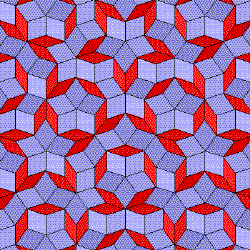Quasicrystal Caught in the Act

Quasicrystals are curious solids whose atomic structures are very regular but which never quite repeat. Normal vibrations such as sound waves can occur in quasicrystals, but they also support phasons–a type of atomic motion not seen in ordinary crystals. In the 21 August PRL a Japanese team reports the first direct observation of these unique atomic motions. Their technique, which uses an electron microscope, could be extended to help answer the fundamental question raised by quasicrystals: Why do they exist, when physicists’ decades-old intuition says they should not be stable?
Quasicrystal structures don’t have a simple “unit cell” that can be repeated periodically in all directions to fill space, although they do have local patterns that repeat almost periodically. They also have local rotational symmetries–such as those of a pentagon–that cannot exist in ordinary crystals. The best known examples resemble so-called Penrose tilings, which use repeated copies of two different rhombi to cover an infinite plane in intricate, interlocking patterns.
Phasons can occur because of the extra complexity in quasicrystal structures. In decagonal quasicrystals, for example, the atomic planes are “tiled” by more than one shape, so some atoms can fluctuate between two nearby positions in a way that exchanges the positions of tiles without disrupting each tile’s shape. Now Keiichi Edagawa of the University of Tokyo and his colleagues have captured these uniquely quasicrystalline fluctuations on film. While others have demonstrated phason motions based on “frozen in” disorder, the Japanese team caught phasons in action by heating an aluminum-copper-cobalt alloy to 1123 K and continuously observing it with a high resolution transmission electron microscope (HRTEM). “It is not very easy to take high-resolution images at high temperatures,” says Edagawa, but the team’s series of images shows a single white dot “flipping” from one configuration to another, and back again, in 115 seconds. Although the white dots actually represent columns of atoms along the direction of the HRTEM beam, their motion is consistent with the mathematical description of phason fluctuations.
Experts discuss two different models to explain the stability of quasicrystals: The energetic model contends that, as with conventional crystals, the quasicrystalline configuration minimizes energy. According to the “random tiling” model, however, phasons cause quasicrystals to continually jostle among competing, structures with equal energies, and their true ground state would be a traditional crystal, if it could be reached. The problem is that, when cooling a quasicrystal, “you get stuck out of equilibrium,” says Michael Widom of Carnegie Mellon University in Pittsburgh. Phason fluctuations are expected to exist at high temperatures in either case, but some critical tests may come after researchers analyze many more phasons and examine their temperature dependence in light of each theory’s predictions.
“It opens the door to lots of detailed tests of the dynamics,” says Chris Henley of Cornell University. Paul Steinhardt of Princeton University is also impressed: “An important characteristic of quasicrystals has now been seen in a dynamical way.” Widom notes that the ability to cool a quasicrystal while keeping an eye on the phasons and verify that they are in equilibrium is “one of the great promises of Edagawa’s experiment.”
More Information
Paul Steinhardt’s quasicrystals page
Michael Widom’s quasicrystal page
Introduction to quasicrystals from Cornell
Penrose and related tiling: de Bruijn tilings


